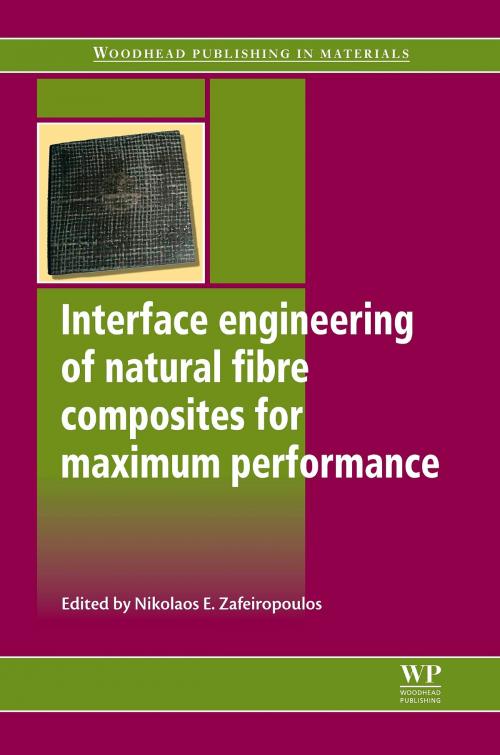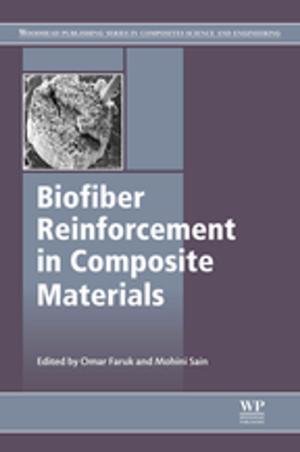Interface Engineering of Natural Fibre Composites for Maximum Performance
Nonfiction, Science & Nature, Technology, Textiles & Polymers, Material Science| Author: | ISBN: | 9780857092281 | |
| Publisher: | Elsevier Science | Publication: | February 26, 2011 |
| Imprint: | Woodhead Publishing | Language: | English |
| Author: | |
| ISBN: | 9780857092281 |
| Publisher: | Elsevier Science |
| Publication: | February 26, 2011 |
| Imprint: | Woodhead Publishing |
| Language: | English |
One of the major reasons for composite failure is a breakdown of the bond between the reinforcement fibres and the matrix. When this happens, the composite loses strength and fails. By engineering the interface between the natural fibres and the matrix, the properties of the composite can be manipulated to give maximum performance. Interface engineering of natural fibre composites for maximum performance looks at natural (sustainable) fibre composites and the growing trend towards their use as reinforcements in composites.
Part one focuses on processing and surface treatments to engineer the interface in natural fibre composites and looks in detail at modifying cellulose fibre surfaces in the manufacture of natural fibre composites, interface tuning through matrix modification and preparation of cellulose nanocomposites. It also looks at the characterisation of fibre surface treatments by infrared and raman spectroscopy and the effects of processing and surface treatment on the interfacial adhesion and mechanical properties of natural fibre composites. Testing interfacial properties in natural fibre composites is the topic of part two which discusses the electrochemical characterisation of the interfacial properties of natural fibres, assesses the mechanical and thermochemical properties and moisture uptake behaviour of natural fibres and studies the fatigue and delamination of natural fibre composites before finishing with a look at Raman spectroscopy and x-ray scattering for assessing the interface in natural fibre composites
With its distinguished editor and international team of contributors Interface engineering of natural fibre composites for maximum performance is an invaluable resource to composite manufacturers and developers, materials scientists and engineers and anyone involved in designing and formulating composites or in industries that use natural fibre composites.
- Examines characterisation of fibre surface treatments by infrared and raman spectroscopy and the effects of processing and surface treatment
- Reviews testing interfacial properties in natural fibre composites including the electrochemical characterisation of the interfacial properties of natural fibres
- Assesses the mechanical and thermochemical properties and moisture uptake behaviour of natural fibres and studies the fatigue and delamination of natural fibre composites
One of the major reasons for composite failure is a breakdown of the bond between the reinforcement fibres and the matrix. When this happens, the composite loses strength and fails. By engineering the interface between the natural fibres and the matrix, the properties of the composite can be manipulated to give maximum performance. Interface engineering of natural fibre composites for maximum performance looks at natural (sustainable) fibre composites and the growing trend towards their use as reinforcements in composites.
Part one focuses on processing and surface treatments to engineer the interface in natural fibre composites and looks in detail at modifying cellulose fibre surfaces in the manufacture of natural fibre composites, interface tuning through matrix modification and preparation of cellulose nanocomposites. It also looks at the characterisation of fibre surface treatments by infrared and raman spectroscopy and the effects of processing and surface treatment on the interfacial adhesion and mechanical properties of natural fibre composites. Testing interfacial properties in natural fibre composites is the topic of part two which discusses the electrochemical characterisation of the interfacial properties of natural fibres, assesses the mechanical and thermochemical properties and moisture uptake behaviour of natural fibres and studies the fatigue and delamination of natural fibre composites before finishing with a look at Raman spectroscopy and x-ray scattering for assessing the interface in natural fibre composites
With its distinguished editor and international team of contributors Interface engineering of natural fibre composites for maximum performance is an invaluable resource to composite manufacturers and developers, materials scientists and engineers and anyone involved in designing and formulating composites or in industries that use natural fibre composites.
- Examines characterisation of fibre surface treatments by infrared and raman spectroscopy and the effects of processing and surface treatment
- Reviews testing interfacial properties in natural fibre composites including the electrochemical characterisation of the interfacial properties of natural fibres
- Assesses the mechanical and thermochemical properties and moisture uptake behaviour of natural fibres and studies the fatigue and delamination of natural fibre composites















